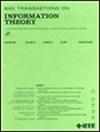散斑噪声比加性噪声更难消除吗?
IF 2.9
3区 计算机科学
Q3 COMPUTER SCIENCE, INFORMATION SYSTEMS
引用次数: 0
摘要
我们研究了同时存在散斑和加性噪声的函数估计问题,通常称为去散斑问题。虽然加性噪声在非参数估计中得到了深入的研究,但在合成孔径雷达、超声成像和数字全息等应用中普遍存在的散斑噪声却没有得到足够的重视。因此,对抑制散斑噪声的基本限制缺乏理论研究。本文是填补这一空白的第一步。我们的重点是研究用于估计$\beta $ -Hölder连续函数的极大极小估计误差,并确定极大极小风险的比率。具体来说,如果n表示数据点的个数,f表示待估计的底层函数,$\hat {\nu }_{n}$是对f的估计,$\sigma _{n}$是加性高斯噪声的标准差,那么$\inf _{\hat {\nu }_{n}} \sup _{f} \mathbb {E}_{f}\| \hat {\nu }_{n} {-} f \|^{2}_{2}$的衰减速率为$\left ({{\max (1,\sigma _{n}^{4})/n}}\right)^{\frac {2\beta }{2\beta +1}}$。将此速率与纯加性噪声(即$\left ({{\sigma _{n}^{2}/n}}\right)^{\frac {2\beta }{2\beta +1}}$)下的速率进行比较,可以得出以下结论:1)当$ \sigma _{n} = \omega (1) $时,加性噪声似乎是去斑点问题的主要组成部分。然而,散斑噪声的存在显著地使减轻其影响的任务复杂化。结果,风险从比率$ \left ({{ \sigma _{n}^{2} / n }}\right)^{\frac {2\beta }{2\beta +1}} $(仅具有加性噪声的问题的特征)增加到同时存在斑点和加性噪声的$ \left ({{ \sigma _{n}^{4} / n }}\right)^{\frac {2\beta }{2\beta +1}} $。2)当$ \sigma _{n} = o(1) $时,加性噪声的方差对去斑点问题的风险没有贡献。这表明,在这种情况下,散斑噪声是主要的瓶颈。有趣的是,由此产生的风险率与$ \sigma _{n} = \Theta (1) $减轻纯加性噪声的比率相匹配。3)当$\sigma _{n} = \Theta (1)$时,这两个速率一致,表明散斑噪声和加性噪声都对总体误差有贡献。本文章由计算机程序翻译,如有差异,请以英文原文为准。
Is Speckle Noise More Challenging to Mitigate Than Additive Noise?
We study the problem of estimating a function in the presence of both speckle and additive noises, commonly referred to as the de-speckling problem. Although additive noise has been thoroughly explored in nonparametric estimation, speckle noise, prevalent in applications such as synthetic aperture radar, ultrasound imaging, and digital holography, has not received as much attention. Consequently, there is a lack of theoretical investigations into the fundamental limits of mitigating the speckle noise. This paper is the first step in filling this gap. Our focus is on investigating the minimax estimation error for estimating a $\beta $ -Hölder continuous function and determining the rate of the minimax risk. Specifically, if n represents the number of data points, f denotes the underlying function to be estimated, $\hat {\nu }_{n}$ is an estimate of f, and $\sigma _{n}$ is the standard deviation of the additive Gaussian noise, then $\inf _{\hat {\nu }_{n}} \sup _{f} \mathbb {E}_{f}\| \hat {\nu }_{n} {-} f \|^{2}_{2}$ decays at the rate $\left ({{\max (1,\sigma _{n}^{4})/n}}\right)^{\frac {2\beta }{2\beta +1}}$ . Comparing this rate with the rate achieved under purely additive noise, namely $\left ({{\sigma _{n}^{2}/n}}\right)^{\frac {2\beta }{2\beta +1}}$ , leads to the following insights: 1) When $ \sigma _{n} = \omega (1) $ , the additive noise appears to be the dominant component in the de-speckling problem. However, the presence of speckle noise significantly complicates the task of mitigating its effects. As a result, the risk increases from the rate $ \left ({{ \sigma _{n}^{2} / n }}\right)^{\frac {2\beta }{2\beta +1}} $ , which characterizes the problem with only additive noise, to $ \left ({{ \sigma _{n}^{4} / n }}\right)^{\frac {2\beta }{2\beta +1}} $ in the presence of both speckle and additive noise. 2) When $ \sigma _{n} = o(1) $ , the variance of the additive noise does not contribute to the risk in the de-speckling problem. This suggests that, in this regime, speckle noise is the primary bottleneck. Interestingly, the resulting risk rate matches the rate for mitigating purely additive noise with $ \sigma _{n} = \Theta (1) $ . 3) When $\sigma _{n} = \Theta (1)$ , the two rates coincide, suggesting that both the speckle noise and additive noise are contributing to the overall error.
求助全文
通过发布文献求助,成功后即可免费获取论文全文。
去求助
来源期刊

IEEE Transactions on Information Theory
工程技术-工程:电子与电气
CiteScore
5.70
自引率
20.00%
发文量
514
审稿时长
12 months
期刊介绍:
The IEEE Transactions on Information Theory is a journal that publishes theoretical and experimental papers concerned with the transmission, processing, and utilization of information. The boundaries of acceptable subject matter are intentionally not sharply delimited. Rather, it is hoped that as the focus of research activity changes, a flexible policy will permit this Transactions to follow suit. Current appropriate topics are best reflected by recent Tables of Contents; they are summarized in the titles of editorial areas that appear on the inside front cover.
 求助内容:
求助内容: 应助结果提醒方式:
应助结果提醒方式:


